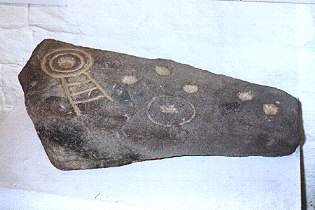
| Cup and Ring carvings ......... What are they ?? |
The term "Cup and ring carving" describes a range of rock carved symbols (petroglyphs) that are found mainly in northern England and Scotland, (although similar carvings occur in other countries around the world). In Britain the carvings are estimated to be around 4000 - 5000 years old which dates them to the Neolithic and Bronze ages.
Generally the carvings occur as.......
The above descriptions cover the majority of Britain's rock carvings, although other rarer motifs do exist, these include spiral channels, cups in rosette patterns, chevron channels, ladder, grid and comb like motifs.
Close examination of un-eroded carvings show that the symbols were often pecked into the rock surface using a pointed tool around 0.5cm in diameter, with metal, flint and deer antler being suggested as a possible tool materials. A "new" cup and ring carving has been created by archaeologists using a deer antler pick and this stone (shown below) is now on display in the Manor House museum, Ilkley, West Yorkshire. This modern carving also illustrates how the symbols would stand out against the darker rock surface when first carved.

Currently the purpose and meaning of the symbols remains unclear, many theories have been suggested but no clear picture has emerged. Some general comments can be made about the siting of carved stones which may provide clues to their function.